Title: | Guest contribution: Derelict Buildings on the Eastern Escarpment: an architectural guide, by Chris Hodges |
Date: | 2017 |
Guest contribution
Dr Chris Hodges has generously prepared this article at the invitation of the Ewyas Lacy Study Group, bringing a unique authority to the study of derelict stone buildings by combining his professional knowledge of drystone walling, thorough field work and a review of the historical context. The sites discussed , in Longtown and Llanveynoe, are elsewhere included in Dr Hodges’ seminal book Derelict Stone Buildings of the Black Mountains Massif which covers a much wider geographical range The article below offers scope for more detail on specific local sites in this corner of Herefordshire.
Ewyas Lacy Study Group
Derelict Buildings on the Eastern Escarpment: an architectural guide
Introduction
Within the valleys of the Black Mountains Massif are numerous derelict buildings built using the indigenous Old Red Sandstone (ORS). The locations and types of these buildings, their modes of construction and layouts have been extensively discussed in previous work Hodges (2015). This present article is area specific for the ELSG and relates to the derelict stone buildings recorded in sections of the Longtown and Llanveynoe parochial areas on the eastern escarpment extending from the parochial boundary of Bwlch Trewyn into and around the Olchon Valley , ending at the base of Crib-y-Garth (SO288328) see Fig 1 .

Fig 1
© OS 1:50000 Landranger (2005)
The groundwork comprised numerous visits in all seasons to find the sites and the primary search route followed the approximate line of the mountain wall marked as a red line in Fig 1 ; the Olchon valley boundary is shown as a green line. Note the small enclosed areas above the wall line. A number of these contained derelict buildings and along with the mountain wall are discussed later.
Overview
To understand these buildings they need to be put into context from both their physical and historical aspects. The first section of this article covers the physical context and describes their geographical location, the geological background of the building material and how it was used. It concludes with a pictorial guide to the various styles of the buildings found in this area. In addition, various points relating to the historical context are highlighted as they occur within the narrative.
The second section is an explanation of their historical context and discusses why they are there, who built them and when were they built. This section also includes possible reasons for their abandonment and subsequent dereliction.
To access the section click on the headings below.
|
| Section 1
Section 2 |
|
The Black Mountains comprise an upland area of approximately 160 square kilometres in SE Wales with an area of continuous ground above 2000 feet second only in extent to Snowdonia, McCaw (1936:6). The section of the Hatterall Ridge in Herefordshire is the highest landmass in England south of Yorkshire .
acking any definitive peaks, the Black Mountains are extant remains of a sandstone plateau dissected across the millennia by glacial and fluvial processes. The resultant topography shows a summit with plateau characteristics divided by a series of almost parallel valleys lying in a NW to SE alignment. Apart from the southern boundary where the valley openings are located, the entire Massif is demarcated by a steep sided and often scalloped escarpment.
Nowadays an observer looking at the eastern escarpment will see a landscape with two distinctive forms Fig 2 .
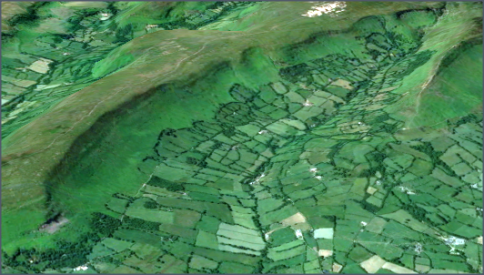
Fig 2
© Google Earth (2016)
The lower comprises an extensive field pattern enclosed within hedges and a small number of isolated farmsteads. Consistently above the 300 metre contour, the upper landscape rises from an irregular but distinct line to the visible ridge horizon. This latter landscape is obviously different; it is higher, steeper and has no discernible field pattern or evidence of any similar buildings.
One could speculate whether the eastern escarpment Fig 3 was the first sighting of the Black Mountains for the various invaders over the centuries as they moved westwards over what is now the Herefordshire Plain.

Fig 3
Having a generally easterly aspect, the dark appearance may well account for the relatively modern name of the Black Mountains . Historical accounts show that they had little strategic value and no exploitable mineral wealth. As a result they were bypassed; the Romans and the Normans used the Wye and Usk valleys as their primary access routes into mid Wales .
This article relates to the area which forms the margin between the two landscape types. It is a fuzzy boundary as there is little real difference in the land directly either side of the boundary and it has no consistent width. However, on the ground and shown on some maps there is a built boundary in the form of the mountain wall discussed later; an important historical feature.
Along the escarpment, derelict buildings were recorded lying above and below the boundary wall line and they might be called marginal. In the Olchon valley derelict buildings were found not only along the same boundary but also within the valley and on the valley floor; Fig 4 shows Cornelau located alongside the Olchon Brook. In this respect the Olchon was similar to the larger valleys in the Black Mountains .

Fig 4
Altitude and Aspect
Altitude and aspect are two important physical features. The general consensus is that upland is land above the 240 metre contour; all the escarpment sites and those around the Olchon valley were above the 300 metre (985 feet) contour. The Black Mountains valleys have a NW to SE alignment which means that the eastern escarpment and western flank of the Olchon valley have an easterly aspect with only the eastern flank benefitting from insolation (direct sunshine) into the afternoon.
This potentially unfavourable aspect in respect of reduced growing time for grass and the general well being of residents especially in the winter months is shown in Fig 5 comparing Clodock and the escarpment.
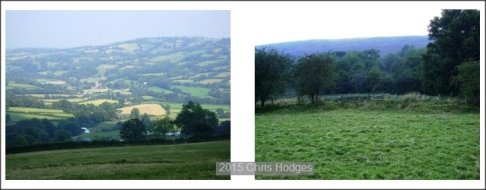
Fig 5
Both photographs were taken on a clear day from the same place at 3pm in late summer.
Prior to and at the time of building 16 th century onwards, this higher land would not have been looked on favourably from below and was considered as waste. This description is often confusing but simply means unexploited or uncultivated land. A typical opening entry in manorial court records from that time was that a named tenant ‘… had enclosed x acres of the Lord’s waste …’ where the lord was the lord of the Manor and/or the incumbent marcher Lord. This area was neither wholly English nor Welsh; it was part of the Marches .
Acclivity
General acclivity of the area should be mentioned to complete this section. Based on the OS 1:10000 map but with overlying 5 metre contours, Fig 6 shows the Olchon valley and adjoining escarpment. Note the relative flatness of the ridge top compared to the general acclivity of the escarpment.

Fig 6
© OS 1:10000 (2016)
This situation on the ground is shown in Fig 7 ; Penwyrlod above Longtown.

Fig 7
Fig 8 shows a similar downslope view of Boskyn in the Olchon valley.
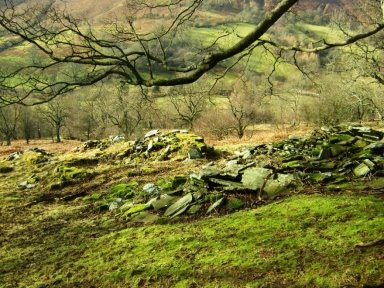
Fig 8
Iorwerth Peate (1940) quoted FJ North thus – ‘ The adaptability of a stone for building purposes depends on its lithological characters e.g. its hardness and durability, the development of planes of weakness such as bedding, jointing and cleavage that may facilitate the quarrying and dressing of stone or may on the other hand render it useless for constructional work’. Accounts of regional or local geology typically comprise an analysis of the various rock types with an estimation of their age and mode(s) of deposition. However whilst such details are important in that context, the relationship between a basal geology and its subsequent historical exploitation is seldom mentioned in any detail. The following sections discuss the geological properties of ORS that facilitated the construction of buildings.
In the absence of geology with requisite properties, the subject of this article would not exist. There is an intimate relationship between the buildings and the underlying geology; they are one and the same material. In addition, they are inherently related to chronic human exploitation of a benevolent regional geology which provided a building material for the construction of permanent weatherproof structures and a soil base that combined with a climate type allied to the topography, supported plant growth. Whilst readily acknowledging the importance of other external and internal factors as discussed later, this combination enabled the subsequent development of pastoral farming that is still ongoing throughout the majority of this region
Stratigraphy
Forming a major section of the Lower Devonian division of ORS which extends across Herefordshire, Monmouthshire and Breconshire and originally formed between 410 and 380 million years ago, the Black Mountains are divided into three primary strata. In descending order they are the Brownstone formation ( BR ), the Senni Formation ( SN ) and the St Maughams formation ( SM ), Fig 9 . The resultant terrain topography reflects the underlying resilience of these individual beds with the Brownstones being the hardest.



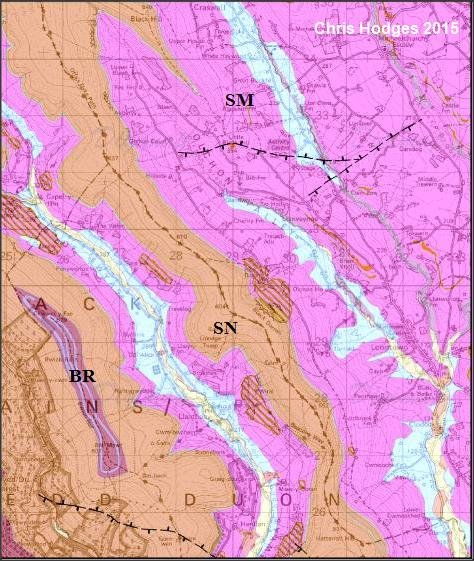
Fig 9
© BGS (2004)
The Brownstones formation is approximately 200-220 metres in depth and forms the majority of the ridge summits. The Senni formation is between 220-260 metres in depth and forms the entire Hatterall ridge including its northern Black Mountain continuation above the 550 metre contour and the 600 metre contour on the eastern escarpment into the Olchon valley. The St Maughams formation is approximately 300 – 350 metres in depth and forms the slopes of the eastern escarpment and the Olchon Valley below the 600 metre contour. In this latter locality is it separated from the over lying Senni formation by an almost continuous strip of limestone about 2 metres deep, Fig 10 .
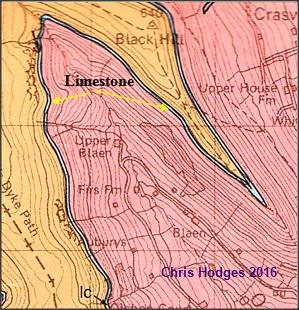
Fig 10
© BGS (2004)
Fig 10 shows that the thin bed of nodular calcrete limestone known as Ffynnon limestone occurs as an isopleth (continuous bed) in the Olchon valley. Fig 11 shows the general appearance of this calcareous layer.

Fig 11

The limestone would have been burnt in drystone kilns deliberately sited in banks/hillsides to gain insulation. Constructed of sandstone, they were built in varying styles such as those shown in Fig 12 in the upper Olchon valley and Fig 13 above Rhyd Lâs .
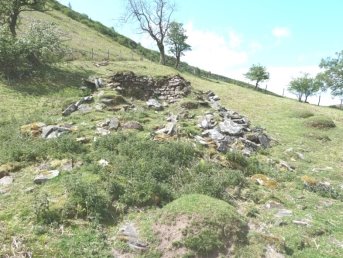
Fig 12
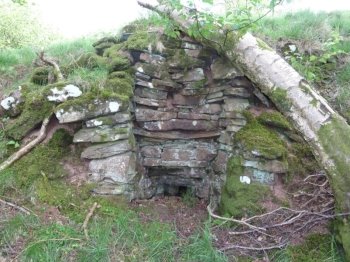
Fig 13
Known locally as cornstone, the limestone burnt in these kilns produced both agricultural lime and lime for building mortar. However, the cost of lime production and its transportation in the late 17 th and early 18 th centuries may have been an important factor when undertaking the construction of upland farmsteads de novo or when rebuilding with mortar and reusing stone from an older drystone building. It might then be argued that the absence of readily available lime influenced the mode of construction of some earlier buildings in those valleys. Often showing very low lime content, variants of mortar composition were noted throughout the Black Mountains; in many instances lime was unidentifiable in typical clay based mortars. However this observation has to be partially qualified as all exposed mortars had been subjected to chronic climatic conditions and lime is inherently water soluble. Only detailed chemical analysis and outside the remit of this study would identify the absence or presence of lime.
Important points within the geological background and directly related to the construction of buildings were relatively simple access to extensive amounts of useable stone, secondly the lithological characteristic of anisotropy (see below); lastly the regular occurrence of fracture lines across the depositional bedding planes creating natural sources of quoins (stones with right angled corners) essential for the construction of all recto-linear openings such as doorways and windows.
Anisotropy
Anisotropy can be defined as the difference in the physical or mechanical properties of a material along different axes. A common practical example is the difference between splitting wood along as opposed to against the grain. A sparkling effect resulting from direct sunlight on the surfaces of ORS is due to reflection off micaceous crystals in the form of plate like crystalline structures; their presence in sedimentary rocks such as ORS aids splitting. When struck, splitting can occur either along bedding planes or in some cases may allow rock to be split along a line that is not a full bedding plane. With regard to sandstone this means that when hit by a hammer or subjected to any unidirectional force, the stone will readily split in preferred planes. As a result the splitting and shaping of a piece of sandstone is controllable as it does not shatter and render the resultant pieces useless for building purposes.
The typical subsoil appearance of sandstone after exposure is shown in Fig 14 .

Fig 14
Visual examination of such exposures aids an explanation for the widespread use of this stone type in architectural history. Fig 14 shows that in the vertical plane the deeper one goes the relative thickness of the beds increases. In practical terms it also indicates that suitable stone for building was relatively superficial and readily accessible.
Examination of the overall exposed surface demonstrates a distinctive reticular pattern of naturally occurring horizontal and vertical cracks; they are indicative of differing events during and subsequent to the initial formation of the stone. These events included pressure from below and more importantly during geological time, erosional effects relieving the over burden of the differing strata above. One fortunate example was the later deposition of water soluble Ffynnon limestone. In solution it flowed down through cracks to form the evaporite deposits described earlier.
Indicative of sedimentary rocks, the horizontal cracks in ORS indicate bedding planes and each represents a break in the continuity of sedimentation. The vertical distance between such planes determines the thickness of beds which can vary from 1cm up to 1 metre. A characteristic feature of many outcrops is a succession of horizontal splits in the stone; the splits having a similar orientation to the bedding planes as seen in Fig 15.
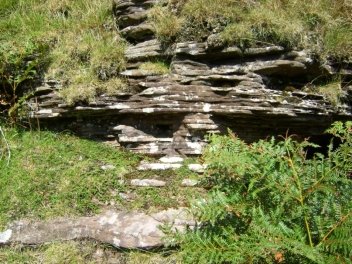
Fig 15
This feature is due to a combination of chronic environmental actions and an inherent property of the stone with direct relevance to its subsequent use in masonry. In practical terms, the end product of this natural splitting process are large flat sheets of stone of uniform thickness known as flags with individual pieces commonly referred to as flagstones. The widespread availability of this type of stone is possibly why many of the ground level floors in the recorded buildings were built of such stone and not simply formed from beaten earth.
For builders, an additional benefit of sheets of uniformly thick stone was that they provided a source of resilient roofing material in the form of roof tiles see Hughes (2003). Their use is an example of ‘ One of the happy accidents of vernacular architecture is that walling and roofing materials tend to stem from similar roots and give unity to the two parts of the building’ Brunskill (1981:96).
Another important feature regarding the use of the stone in the buildings under investigation was that the joints occurred as vertical lines and that the opposing faces within such joints often lay at ~ 90° to the external face; thereby providing a ready source of natural quoins and building stone with smooth faces. This latter aspect is why in the masonry of the Black Mountains, sandstone has a flattish face (external surface) often mistakenly described as having been dressed. Additionally, my fieldwork indicated that the majority of quoin in situ did not exhibit chisel marks indicative of pre-operative dressing .
The existence and importance of quoins in the historical development of building technology has been occasionally recognised in the past by writers describing geology in Wales and the limits it imposed on post-medieval masonry. Discussing the use and inherent strength of correctly laid quoins in buildings such as those in this present study, Smith (1975:73) wrote – ‘ The masons generally worked within the limitations of local geology and though stone was abundant, good workable freestone was only available in a few places. Many districts were without limestone for making mortar and as a result rough and rugged rubble walling was general. Stones were bedded in clay and the builders relied on the width of the walls and the strength of quoins for stability’.
Similarly Fox and Raglan (1994:36) in a description of a building wrote “… a roofless ruin built of coursed rubble with large stone quoins” ; one of a very small number of derelict buildings examined by those authors in their study of Monmouthshire Houses.
My personal opinion is that descriptions such as rough and rugged rubble walling and coursed rubble which are typical of many published and cited articles do a disservice to the historical skills involved and quality of the masonry under discussion; a topic for discussion elsewhere.
The building material that Smith, Fox and Raglan referred to as rubble is the same stone type used to build Llanthony Priory in the 12 th century and described by Giraldus Cambrensis as – ‘… it is a remarkable circumstance or rather a miracle concerning Llanthoni [sic] … that Parian stones are frequently found there … and with these the church is beautifully built’. The archaic reference to Parian relates to a smooth marble form of limestone found in the Eastern Mediterranean region.
Nowadays the widespread availability of software enables researchers using digitised maps and satellite imagery to undertake desk based analyses when examining remote areas. Whilst such software is a valuable aid, to find many of the features under discussion a search on foot was essential. Irrespective of their locations in woodland or open fields, being derelict many of the sites were either never recorded or are no longer recorded. Two examples are Whitehall on the opposite side of the road to Firs Farm and secondly the house at Penywyrlod. The latter was demolished in the 1960’s and Whitehall presumably met a similar fate. To locate such sites the technique used was map regression analysis which is the study of a sequence of maps to show changes of features in an area over a period of time, Aston (1985:18).
Most of the derelict buildings were located using a combination of three maps; Tithe maps drawn up circa 1840’s, the Ordnance Survey 6" to the mile (now 1:10,000) maps and the latest OS 1:25000 maps. Of these the most useful were the earlier OS maps; my preference was for the 2nd edition 6" maps published around 1903. Using this combination enabled most of the sites to be located and in many cases named. However a number of previously unrecorded small sites were also found Fig 16; given their degree of dereliction and possible age they will likely remain anonymous and of unknown function.
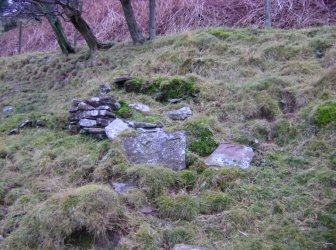
Fig 16
Mountain wall
Used as a guide in locating the sites and integral to the search route shown earlier in Fig 1 was the mountain wall; an important feature and significant part of the historical context discussed later in Section 2. However a brief description is given here.
Nowadays the mountain wall as such does not exist as a continuous free-standing drystone wall; however, the likely original line was still discernible on the ground. Fieldwork showed that numerous sections of the drystone wall had not been maintained and subsequently allowed to fall into disrepair. The result is that all along the Eastern escarpment and into the Olchon valley the boundary comprised a variable pattern of quickthorn hedging, drystone walling or a combination of both. In some sections the boundary had additional wire fencing, indicative of the modern practical and more cost effective approach to stock control and boundary maintenance, Fig 17 .
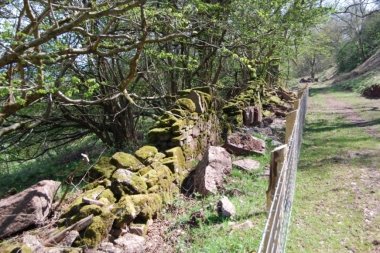
Fig 17
The term mountain wall relates to a constructed boundary that demarcated the lower enclosed and tenanted land from the higher and open common land above. It has been mentioned previously that the Black Mountains are not mountains in the accepted sense and the term mountain wall similarly does not refer to topographical features.
Interpreting topographical nomenclature and place-names is often problematic. Up to the later 18 th century, the prevailing language for the area was Welsh and not always susceptible to direct translation into English. For example, mountain in modern Welsh is mynydd (pl. mynyddoed) and Austin (2006:198) considered that simply translating mynydd as mountain did ‘ a grave injustice to the complexities of Welsh cultural history’ . This view was reinforced by the Geiriadur Prifysgol Cymru (the definitive Welsh dictionary); it gives 12 th century meanings for mynydd as mountain or large hill followed by several 14 th century meanings as commons, unenclosed land, mountain land and moorland and to a lesser extent, agricultural land or a plain. So in this context translating ar y mynydd as ‘on the mountain’ is misleading as it does not simply refer to an individual topographical feature but describes that section of upland landscapes lying above enclosure boundaries i.e. wall(s) ; it could also mean ‘over the wall’ an idiom which correlates with the boundary under discussion.
T he term enclosure is o ften used incorrectly in descriptions of these outermost boundary walls. Usually non-specific and based on their primary function, it relates to their perceived standardised typology. The problem often arises from the case of the initial letter, either E or e as either an Enclosure or enclosure wall. Only a wall whose construction was to a fixed specification as laid down in an Act of Parliament relating to the enclosure of a specific area of land, can be correctly termed E nclosure. Other outermost boundary walls not related to any such specific Enclosure though performing the same function as an Enclosure wall should be described as enclosure walls.
Though all the fields are enclosed, historically there was no E nclosure wall built within the study area as a result of an Act of Parliament, see Kain et al (1995); e nclosure wall is the correct description and is used in this study. However to add to the confusion, Muir (2004:135) states that inclosure, synonymous with enclosure, is a legal concept based on private ownership and does not relate to the land being fenced, walled or hedged.
The questions now arise as to why was the wall built and secondly, built along the observed line. The common sense view would be that in the late 16 th and early 17 th centuries, the wall was primarily built to enclose the maximum acreage of rentable and cultivatable land for the incumbent estate owners. The wall line would have been based on contemporaneous knowledge of climate, drainage and insolation with regard to the production of grass for livestock and to a small extent in this area, arable crop production. At that time, the land above the wall was deemed to be of poor quality and had a low carrying capacity for livestock with a resultant negligible profit margin; a situation largely due to the effects of altitude and aspect.
Similarly any decisions regarding the line of an enclosure boundary and the logistics of building it would have again been based on local knowledge and experience regarding the terrain in question. It is probably a maxim that the numerous estate owners from the monarchy downwards as discussed elsewhere in the ELSG website were absentees; groundwork decisions were likely made on their behalf by appointed officials and resident members of the local community.
The chosen line assumed favourable acclivity, the availability of suitable stone and a competent workforce to enable a wall to be built running across a given slope. These factors would also have influenced the preferred choice of materials, either stone or quickthorn. Drystone walling is unaffected directly by altitude unlike quickthorn hedging which requiring less effort to produce a boundary, was found to be the prevalent choice at all lower levels throughout the Black Mountains. Where local topography such as a steep slope usually greater than 45° dictated its use, quickthorn hedging was the primary choice form along the wall line.
For these short stretches the added effort and cost would not have been deemed an economic solution to a localised problem and hedging would have been chosen as an alternative. However, one of the advantages that drystone walling had over hedging is its immediate efficacy as a boundary as opposed to waiting for the quickthorn hedge to grow; given suitable climatic conditions three to four years before becoming stock proof. Fig 18 shows the use of three identifiable methods of boundary marking still in situ .
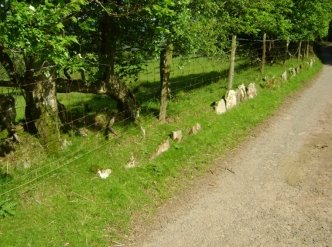
Fig 18
However, these apparently reasonable explanations for the existence and course of the wall are not the complete answer and fail to give the historical background for this extensive linear construction still identifiable throughout the Black Mountains.
Why the wall was built is more complicated and the reasons were cultural. They involved consequential changes in social culture from the medieval feudal manorial type open landscape of Marcher lordships to the early modern enclosed estate type landscape. In the latter, the majority of existing farmsteads were now rented from estate owners under the copyhold system and there was an emerging development of new generally smaller farmsteads.
This transition occurred primarily after the Act of Union in the mid 16 th century and was partly indicative of the end of the medieval period; see the historical context section later in this article.
Having given an account of their landscape background, their general location and the material they were built from, we can now consider the buildings themselves.
Firstly there were some general features common to all the buildings along the escarpment and throughout the Black Mountains and examples will be illustrated in the following narrative. They were all rectilinear, the only exceptions were semi-circular breadovens abutted up to gable ends of some buildings. Secondly, they were all built from the indigenous ORS including the roofs – the only exceptions were a small number of later houses where metamorphic slate was used as the roofing material – these examples were only found on the escarpment and in the Olchon valley.
The mode of construction was variable, either drystone or mortared with the latter using various mortars based on clay or sand with or without lime. Thirdly the predominant alignment was downslope meaning the long axis of the building was at 90° to the underlying contour. A small number were built across slope and my study found this choice to be in widely contrasting locations, either on the steepest slopes Fig 19 or on level ground.
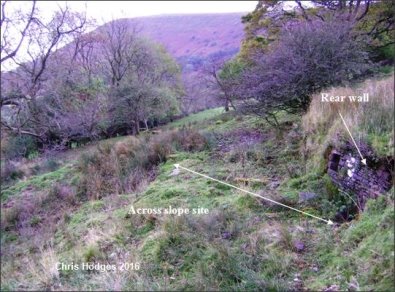
Fig 19
Most authors now accept the reason put forward by Gresham (1954) for the predominance of the downslope alignment of upland buildings. In such areas this alignment offered the least resistance to runoff water flowing down the slopes. My wider study suggested that across slope buildings might have been located on the steepest slopes because in such difficult terrain their construction involved less groundwork, whilst the lower finished wall heights still created an acceptable internal living space.
Lastly and based on the location of doorways and windows, the orientation or direction that buildings faced was related to their alignment. The minority across slope buildings all faced down into the valley whilst the majority downslope buildings tended to face down along the escarpment i.e. away from the Olchon. Two likely reasons were maximum exposure to sunlight and to enable occupants to see what was happening down in the lower levels where most social activity occurred.
This was still the case much later. Built across the slope, Fig 20 shows the rear view and upper gable end of Rhyd Lâs with only two small openings facing uphill.
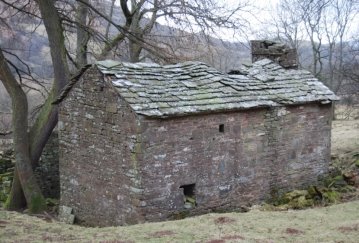
Fig 20
Building types
There were two main types of buildings, houses or more accurately sites of human habitation, and agricultural buildings comprising barns and other structures. An element of doubt exists because without detailed intrusive archaeological investigation, a definitive function could not be ascribed to many sites.
Based on those two types of buildings, a variety of site layouts was recorded with the simplest being a single building whilst the most complex had up to five separate buildings. Within this range lay initially a confusing array of several variants that may indicate a means of dating. A brief explanation here will be illustrated later with examples as this section proceeds.
To date in Wales, no standing vernacular domestic stone building has been dated before 1400, Suggett (2006); timber was the traditional building material. The earliest forms of domestic stone buildings were longhouses identified by the presence of two compartments separated by a cross-passage with opposing entrances. Though also found in lowland areas, the longhouse was a building ideally suited to upland living and its identification and definition has caused many problems in past literature.
he upper compartment would have had a central hearth with no flue whilst the lower would have housed animals. In less settled times, this compact arrangement gave people and their animals, on which their livelihood and very existence depended, a means of protection as well as convenient access. This format was part of their historic culture and as it worked, was adopted in later buildings that were not actually longhouses. This situation led to buildings being given various descriptions such as longhouse derivative and false longhouse; for more information see Smith (1975), Suggett (2006) and Wiliam (2010).
Published surveys such as those carried out in Longtown and Llanveynoe by the Royal Commission in the 1920’s, Jones and Smith (1966/7), Fox and Raglan (1954) all identified longhouses as the basis for some standing houses in the area. No standing houses were investigated in my study and only one site Boskyn Fig 21 may have been a longhouse.

Fig 21
This comment is based on circumstantial evidence and without further intrusive investigation remains speculative. Boskyn is located on the western flank of the Cats Back at 410 metres AOD. On the ground it showed atypical dereliction with opposing and matching dereliction patterns within
both side walls.
Documentary evidence for its English name came from the will dated 1669 of a William Poiskine, Fig 22 . Now held at the National Library of Wales in Aberystwyth, this document showed that he only had one heifer – ideally suited to be kept in a small byre. In Welsh, Poiskine’s house would be Ty Boiskine with the initial P mutated to B; with the decline of Welsh this could then have developed into Boskyn.
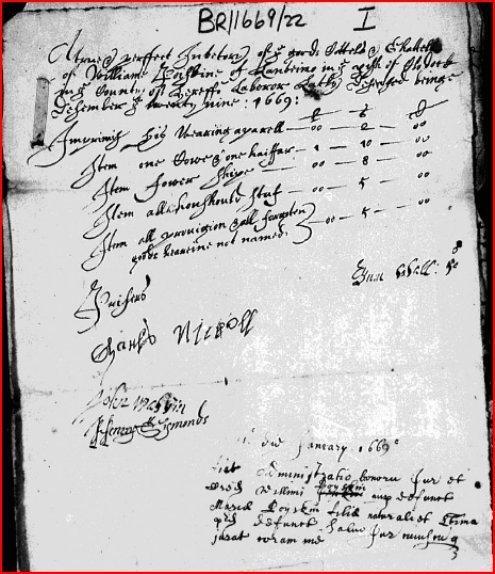
Fig 22
© Nat Library of Wales
From a distance some apparently single buildings were on closer examination found to be complexes of two or more compartments that were not interconnected. One example was Draen Farm; the up valley side view of this downslope building is shown in Fig 23 .
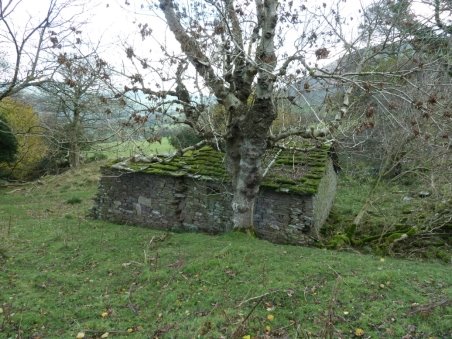
Fig 23
As you approach this site it appears to be a single building. However as shown in Fig 24 , looking up towards the lower gable end, there were other compartments added onto the original building.

Fig 24
This process is building by accumulation , a term first used by Peter Smith (1975) who showed that many buildings which appeared to be longhouses were in fact two or more buildings abutted against each other. This process is readily identified by the presence of vertical joins or breaks in the masonry extending from ground level up to the wall plate. Fig 25 shows this typical appearance at the site now known as Town House; a name possibly derived by anglicisation of Twyn, a common element in Welsh place names.

Fig 25
These vertical joins should not be confused with those forming part of a historic closure of an entrance or window opening such as that seen in Fig 26 ; their presence may also be hidden under layers of render and lime wash.

Fig 26
Draen Farm also showed another historical process identified throughout the Black Mountains which was change of use. Fig 27 shows the interior of the main building.
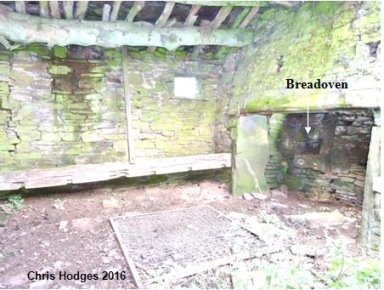
Fig 27
Clearly visible is a large rectangular fireplace formed by two jambs lined with large orthostats covered by a large oak bressumer; there is a breadoven in the typical left hand side position. This internal arrangement indicates that this was at some time a dwelling but post abandonment, a feeding rail was inserted and it became an animal house or a barn.
The occurrence of this transition was deemed an indication that barns remained a useful resource after sites were abandoned and was part of the reason why barns were generally found in less derelict states than houses. Hodges (2015) also showed that abandoned houses became sources of removable artefacts such as tiles, lintels and other timber features such as roof supports and doors. Their removal was a major contributory factor to the subsequent widespread dereliction of many sites.
The next layout form had two or more separate buildings with the living quarters no longer attached to either a barn or an animal house. This was a clear sign of emergent modernity and the cultural movement away from the earlier longhouse traditions. In many instances an animal house or byre was no longer necessary; sheep had become the primary stock animal. A simple example was Rhiw Cwrw with two separate buildings shown later in Fig 31 .
There were several examples of this larger more widespread layout form and they showed differing ages according to the building style. Some were like their smaller counterparts such as Abbey Farm in the Olchon, Fig 28 .
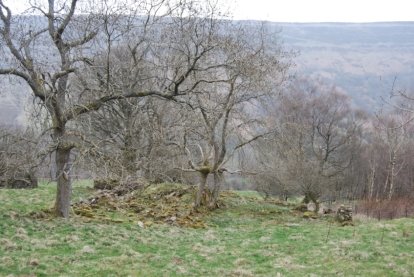
Fig 28
Suggestions are that the name of this site arises from a possible relationship to the adjoining valley and that this farm was originally a grange of Llanthony Abbey, hence the name. There may problems with this derivation. Llanthony Priory became a daughter house of Llanthony Secunda in 1481; after the Dissolution in 1538, its buildings and estate were sold to Sir Nicholas Arnold. No definitive medieval buildings were identified at Abbey Farm and in type and construction the extant remains were typical of the majority of other sites in this area. Standing at approximately 470 metres (1540 feet) AOD and having an unfavourable easterly aspect, this would not have been a first choice site as previously discussed.
Its possible post – medieval origin and the name element Abbey as opposed to Priory might come from being able to see Dore Abbey in the distance or a possible link to Craswall. Ironic historical names are well recognised.
However a caveat is that if documentary evidence is found in the future, this suggestion for the derivation of the name would of course be withdrawn. Castle Farm Fig 37 which overlooks Longtown Castle may well have been another example of an ironic name.
Houses
Houses were identified if two or more of the following diagnostic features were present – name(s), a fireplace, size of entrance(s) and general layout; houses tended to be more complex internally than barns. However as will be shown, these indicators were not always conclusive evidence of a building’s identity or even identifiable at some sites. Fig 29 shows the general house site locations and further details are given in Appendix A.
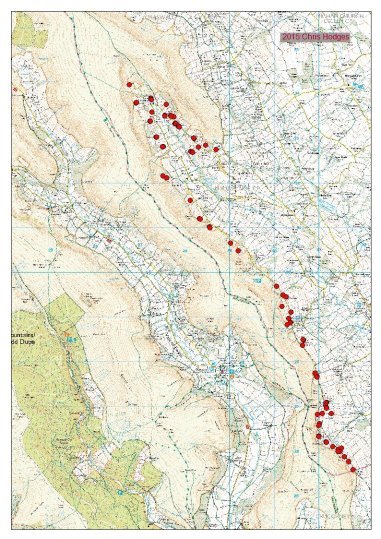
Fig 29
© OS Landranger 1:25000 (2005)
The following section shows examples of the varying types and the degrees of dereliction.
With regard to size and complexity, the remains of the simplest buildings were little more than bumps in the ground. For example Fig 30 shows the site of Strawberry Cottage lying parallel to and just below the mountain wall seen on the left.

Fig 30
Above the mountain wall and within their own separate enclosure are the two buildings at Rhiw Cwrw Fig 31 ; it is likely that these were a house and a barn.


Fig 31
The next type was those buildings where some stone was visible. Fig 32 shows the typical appearance of this type of unmarked and anonymous site; it was probably a field barn.

Fig 32
Fig 33 shows an upper corner quoin that suggests this building had a downslope alignment.

Fig 33
Some of these sites were quite extensive such as Penwyrlod Fig 34 and similarly the anonymous site shown in Fig 35 .
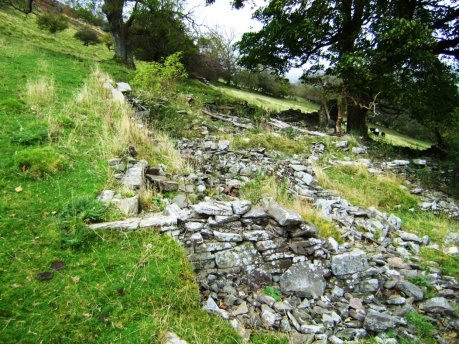
Fig 34

Fig 35
This latter site was an exception; it had a clearly demarcated access track leading away from the site further up into the valley Fig 36 as opposed to the typical down into the valley form. A possible reason is that there may have been a connection with lime production in the adjoining upper Olchon.
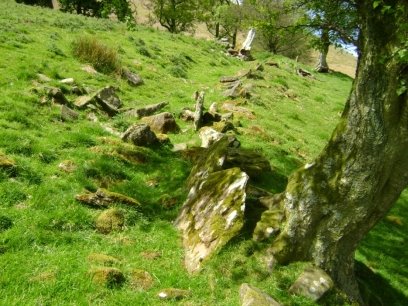
Fig 36
With regard to dereliction, the commonest site type had one or more sections of standing masonry; Fig 37 shows Castle Farm.

Fig 37
The typical standing masonry was often a section of a gable end such as shown in Fig 38 . Gables represented the anchor point for downslope buildings and their general level of survival compared to side walls may indicate that their structural importance was historically well understood.

Fig 38
When looking for identifiable features the most likely sites to find them were within the larger examples. Fig 39 shows the house/barn complex at Ty Canol; a later site that still retained the house barn proximity, another example of building by accumulation.

Fig 39
Fig 40 shows Little Turnant with its impressive chimney stack within the lower gable end.

Fig 40
Physical evidence of roof form and structure was not widespread for reasons already given, but Fig 41 shows Draen Farm with sections of the typical double pitched roof form built with ORS tiles.

Fig 41
Fig 42 shows an internal view of the roof structure; note that the tiles do not have dowel holes. These tiles were not fixed directly onto the battens of roughly hewn branches and were held by the inherent frictional resistance due to their weight.
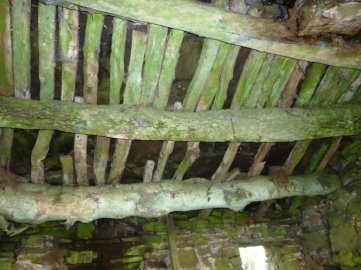
Fig 42
A similar style of roof structure can be seen in Fig 43 at Rhyd Lâs , a much more modern style of house as shown in Fig 44 and discussed later.
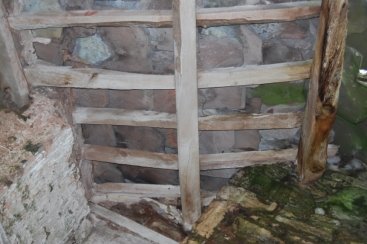
Fig 43
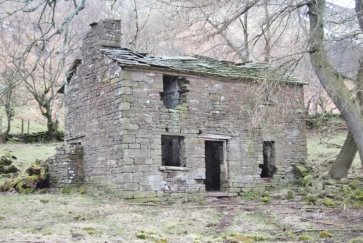
Fig 44
The next form of buildings was primarily within the Olchon valley. All readily accessible from the metalled road, it included The Place, Blaen and Middle Blaen and may have included Penywyrlod and Whitehall mentioned earlier. Dating from the 17 th and 18 th centuries, these sites have been extensively surveyed and documented by Graham Sprackling and the late Jim Tonkin and the reader is referred to their numerous articles written for the Woolhope Naturalists Club in Hereford see www. woolhopeclub .org.uk .
As part of this general explanation of the buildings there are a couple of points of interest I would like to raise. Change of use has previously been mentioned. The Place is a good example from this group and one of the most interesting of the buildings. Fig 45 shows its overall appearance from the road.

Fig 45
The site has the typical downslope alignment and orientation and the farmstead comprises a main building with additional out buildings. Fig 46 shows the upper side wall aspect which atypically has a large window opening and an entrance doorway presumably allowing access to the adjoining outbuilding shown in Fig 47 ; a fairly large structure in its own right.
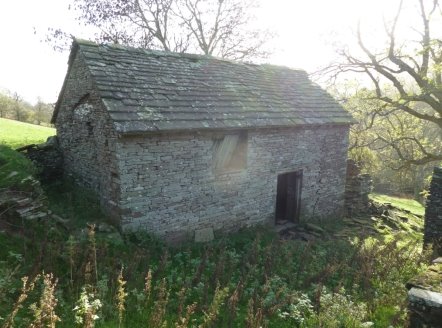
Fig 46
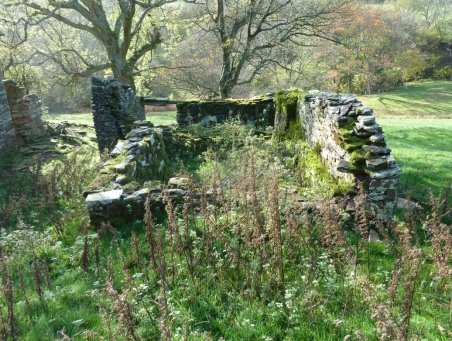
Fig 47
Fig 48 shows a closer view of the lower side wall. There is another entrance atypically in the lower gable end and the window sizes suggests access openings as opposed to being actual windows; in buildings of this type and older forms, no evidence of glazing was found anywhere in the Black Mountains.

Fig 48
The evidence so far suggests that The Place was a site with atypical features for the area.
Fig 49 shows the internal arrangement looking down towards the doorway seen in Fig 48 and the existence a large well built fireplace and flue arrangement, yet no chimney stack is visible in Fig 45 or 46 .
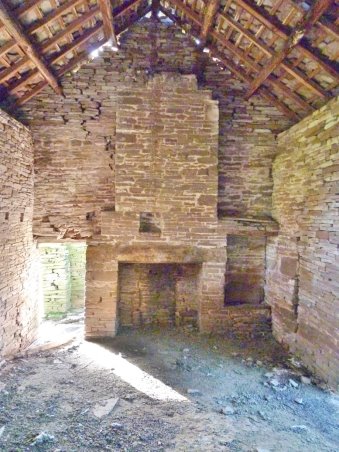
Fig 49
There is a line of small openings in the masonry above the entrance; these are possibly holes into which timber joists were placed which supported an upper floor. Access to this floor was likely from a now missing counter clockwise staircase that would have existed in the opening adjacent to the right of the fireplace. Throughout the Black Mountains this was the typical siting of staircases; adjoining and either to the left or right of a fireplace.
In summary The Place was a site that on initial viewing Fig 45 appeared to be a barn; other than an English name and no historic reference to Y Plas was found, there were no external features indicative of being a house. It might be argued that the large building in Fig 47 was the barn but that was not always the case.
The later houses
The final group of houses to be discussed in this article were in the context of my wider study, peculiar to the eastern escarpment and the Olchon valley; I found no evidence of any similar derelict buildings elsewhere within the Massif. These sites were Wern-y-Cwm, Coed, Auburys, Rhyd Lâs and Blaen Olchon. Based on their overall forms, their roofs and internal structures, all of which would not look out of place today even in a lowland setting, they stood out as being different and far more modern than all the other derelict buildings I recorded in the Black Mountains. In reality they were almost intact and had not suffered extensively from the ravages of time or human
agency; this may be due to their roofs having little perceived value and remained untouched.
Initially what they had in common with earlier sites were location, alignment and orientation and were all built using the local ORS. Where they differed significantly was their external appearance as seen in Figs 50, 52, 53, 55 and 58 showing the facades of these sites. However each of these sites also showed evidence of the social and architectural histories of the region.
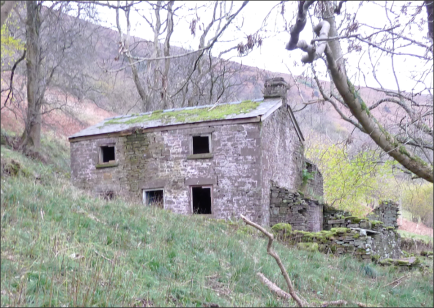
Fig 50
Fig 50 shows Wern-y-Cwm a relatively modern house now derelict but built following long established formats. It had a downslope alignment with a facade facing down along the valley. The fireplace and chimney flue were built as part of the lower gable and as Fig 51 shows, outbuildings were simply abutted against external walls of the original building and there were no windows facing uphill.

Fig 51
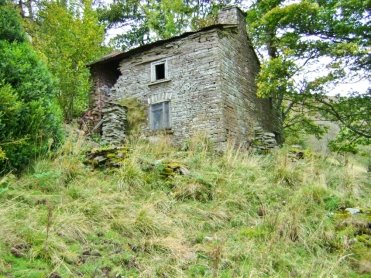
Fig 52
Fig 52 shows the façade of Coed with its two glazed casement windows; the lower has a decorative course of soldier bricks, a rare example of domestic embellishment. Note the large box tree (probably Buxus sempervirens) on the left of this photograph. A fairly common sight throughout the Black Mountains and used by me as a locator, its presence was evidence of a much older apotropaic belief that it offered protection against evil spirits and witches. Probably dating from the 19 th century, for a house such as Coed this symbol was long outdated but when looking behind the house, the reason became obvious. Fig 53 shows the rear gable end of a much older house built into the hillside and located directly behind the house in Fig 52 .
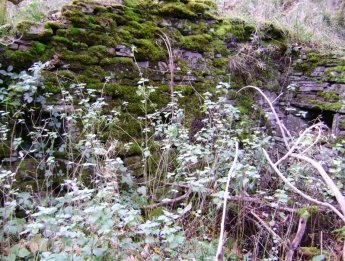
Fig 53
Fig 54 shows that the newer house had been built up against the lower gable end of the earlier house; its associated fireplace and chimney flue are indicated by the arrow.
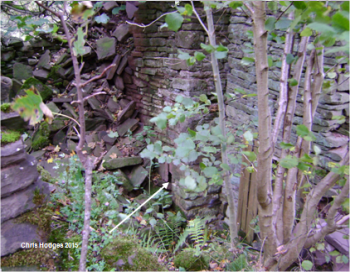
Fig 54
Such an arrangement strongly suggests that this site had a much longer history of occupation than that suggested by the style of Coed seen in Fig 52 . A possible scenario was that the occupants of the older house made the major decision to build the newer house to improve their lifestyle but did not want or were unable to move from that site. This successional history of site occupation in different buildings is known as iteration and though difficult to prove without intrusive archaeological investigation, can likely be applied to many sites of derelict and standing houses.
Fig 55 shows the appearance of Auburys with an across slope alignment and a façade of balanced numbers of glazed openings and a near central placed entrance. The almost intact roof is of slate not the more typical tiles.

Fig 55
Possible evidence for iteration is the large structure seen to the left and shown in more detail in Fig 56.

Fig 56
There is a similar situation at Rhyd Lâs; the main house is seen in Fig 57 .

Fig 57
The style and roof structure has very similar lines to Coed and Auburys and again there is potential evidence of iteration in the form of the structure seen in Fig 58 .

Fig 58
In Fig 58 , the main house can be seen to the right but the large down slope structure again shows the vertical join of building by accumulation and has the typical earlier form of a dwelling attached to a barn. It is again possible that this was the earlier dwelling used until the newer more modern structure was built; it then underwent change of use.
Circumstantial evidence at Auburys whose name has 19 th century origins and Rhyd Lâs would suggest that the latter is the older; Auburys was likely abandoned at a later date. Fig 59 may show a date stone of 1896 at Auburys but this interpretation is open to further investigation.
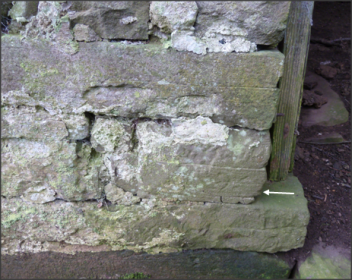
Fig 59
Fig 60 shows Blaen Olchon, the last site in this small group.
East side
West side
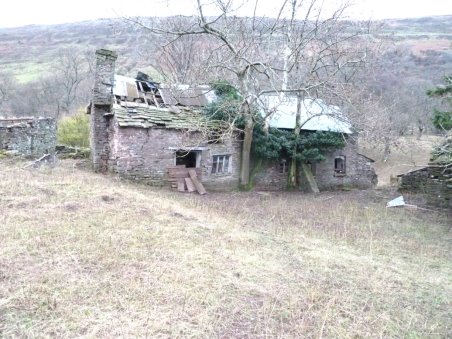
Fig 60
Now derelict, this site was standing and occupied in the 1920’s and formed part of the Royal Commission’s survey of Llanveynoe. From their record card, the inspectors were not able to gain entry and under the heading of Historical Development, the report stated “ The E portion of house is c1700 while W half is probably slightly earlier. In modern times it has be [sic] some what re-modelled”.
When the survey took place over ninety years ago, the study of vernacular architecture was still in its infancy especially with regard to stone buildings in remote areas such as the Olchon valley. At the time there was no metalled road to this site and even now there is still only a track. However their brief description identified the long history of this site and some detail of it is shown in Fig 61 ; the western gable end.
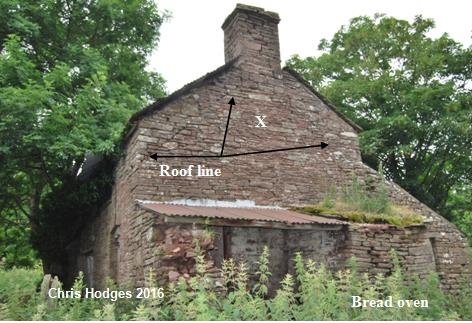
Fig 61
On closer examination of the mortared masonry there are some features which identify various events in this site’s history. Firstly, an earlier roof line visible on both sides. This indicates that the original building was a single storey structure and sometime later, the roof level was raised to provide additional accommodation on a new first floor with access via a staircase.
In the diagonal midline section X there is a change in the character and colour of the stonework probably indicating the later insertion of the chimney probably at the same time as the roof was raised. Under the corrugated iron awning in the lower left foreground is an atypical gable entry whilst in the lower right foreground is a rectangular external bread oven; the typical shape was semicircular.
This last group of derelict buildings have differing histories from the majority on the escarpment, the Olchon valley and within the Black Mountains as a whole. They appear to demonstrate the process of iteration and the attempts of tenants of small upland farms to dramatically improve their living accommodation and lifestyles. As such they may well reflect to a certain degree a similar history with many of the standing occupied houses throughout the area.
This latter topic would be better understood by examining the interiors of these buildings and this will hopefully be done in a future article which will include a detailed description of integral features such as windows, entrances and fireplaces only mentioned briefly in this narrative.
Irrespective of their size and status, all the buildings are of interest. Their presence is tangible evidence of the lifestyles, skills and aspirations of many generations of families that once lived and worked in the Black Mountains; most will likely remain anonymous but are now not forgotten.
So far this article has discussed the physicality of the buildings. This next section deals with their historical background or more correctly that of their wider locality and its population, the people who built them and when.
It is not intended to go into the detailed history of the area, a topic that has been well covered by other authors in the ELSG website and the published literature. Instead this section will simply highlight the historical background situations and sequence of events without which the whole process of construction might never have occurred.
Timescale
The time period this article covers is from the 15 th to the 20 th century and includes the later medieval, the post medieval and the early modern periods. The most important era was the mid 16 th to the mid 18 th century during which ‘ The sea of human activity which had washed up the hillslopes to the edge of the open moor, halted and then ebbed to the bordering lowlands … to leave the neglected fields and ruined farms as beach combings for the geographer’ McCaw (1936) quoted by Howell (1943).
Pertinent questions relate to the dating of the sites and the lack of anything dateable before the 15 th century. In Wales this situation has been ascribed to a lack of security and no-one other than members of the gentry or Church built anything in stone. For the vast majority of the population at the time, having a permanent home that could be passed onto future generations was inconceivable.
According to the Dictionary of English Place Names, the name Ewyas or more correctly Ewias means sheep district in Welsh. However, the name is much older and precedes the influx of sheep from the 13 th century onwards. A 19 th century explanation of the meaning of Ewyas gives a very different meaning and a likely more correct insight into the problems of the region. Roberts (1847) wrote - The derivation of the word Ewyas is from Gwyas, or Gwias, signifying, in the British language , (Welsh) " a place of battle;" and describing, in all probability, the turbulent state of warfare in which the district was always plunged, owing to the clannish and family quarrels of the British (Welsh) among themselves, even before they contested with the Norman Baron, upon that spot, the pass into the mountainous counties, the citadel of their freedom.
In addition there were two events of national significance that also had an influence on this area; these were the Black Death and the Glyndwr revolt. Prior to the Black Death, in the 1320’s there were several years of poor harvest and widespread famine. This meant that an already weakened and reduced population was then devastated by the Black Death twenty years later and then again in the 1360’s. The next event was the Glyndwr revolution at the turn of the 15 th century and this again resulted in devastation for the area, primarily for those of an Anglo-Norman background. There is no evidence that Owain Glyndwr ever ‘visited the area’ himself but Llanthony Priory and Dore Abbey were spared probably because of the spiritual power the Church held at the time; more cynical suggestions include payment of large ransoms. Unopposed raiders would have driven stock away as a food supply and likely burnt many wooden buildings. Documents from the time suggest that the indigenous Welsh speaking population probably supported the aims of Glyndwr and saw the revolution as a means of reducing the power of the incumbent Lords had over them. Apart from a few named individuals, Patent rolls of 1408 record that Henry IV granted pardons to the surviving population of the Black Mountains en masse.
General demographic decline meant that for absentee landowners the land they owned had become became less valuable. Without the peasantry they had no labour force to tend stock and plant crops and then bring in whatever harvest was available. In addition without these people there was a limited source of income. The results of these events in Wales and elsewhere were significant factors in the subsequent demise of the feudal system with tenants working on a subsistence level; the emergence of the post-medieval market system meant that tenants were able to sell their produce.
One innovative example was the transition from cattle to sheep as the primary stock animal. A greater labour force was needed to tend to cattle whilst large flocks of sheep could be tended by a solitary or small numbers of shepherds. The emerging wool market was a means of acquiring great wealth with little outlay; anyone with land could raise sheep and make money. Land that was marginal or not suitable for arable farming could be assarted or cleared of woodland. The harvested wood could be used as fuel or in manufacturing processes and the cleared land converted into grassland as either pasture or meadow on which sheep could then be raised.
So the scenario in the latter years of the medieval period, late 15 th and early 16 th centuries was of a slowly recovering but reduced population. However, some enterprising local families used the advantages they had gained from this widespread situation and started to acquire further land and increase their local influence.
At this time all land was held by the Lord of the Manor and local families were in fact tenants. Their tenancies were a mixture of ancient rights and freeholds based on Welsh laws gained centuries earlier from the Normans and the more modern form known as copyhold. The latter held a copy of a document issued by a manorial, in name only, court which gave them tenancy of a piece of land on payment of a stated rent for the duration of their life. The tenants who held ancient rights held their lands in service; known as customary tenants, their occupation of land was based on ancient customs and did not pay fixed rents.
The system originally based on feudal services and subsistence economy was now declining. By allowing members of local families to encroach onto the waste, land that was previously unproductive both in fiscal and agricultural terms was now becoming a potential source of income. This new land was not governed by ancient rights and so, rents could now be set at current market rates. Land was becoming a marketable commodity which was now measurable and rents were being assessed and charged based on a fixed rate per acre.
In the middle of the 16 th century another major event occurred that influenced the area, this was the Act of Union between England and Wales ordered by Henry VIII. It meant the end of the Marches and Marcher lordships, the establishment of new counties such as Breconshire and Monmouthshire and the adoption of English law throughout England and Wales. Within this latter aspect was a fundamental change in the process of inheritance.
In Wales and some of the Marches the traditional form of inheritance was gavelkind whereby all the children of a deceased person were entitled to an equal share of the estate. Though superficially democratic and fair, in reality it meant small farms being divided into a number of even smaller farms each with less likelihood of being economically viable and able to support a family. Comments about fratricide being a common crime have been made in the literature. The English system was primogeniture which meant the first born had primary claim to the estate. This still left the other dependents without a foreseeable future with regard to having any land of their own, building a home and raising a family. It is now suggested that it was these potentially landless members of the local communities that became encroachers.
The evidence for this statement is a mixture of circumstantial and documentary evidence. Examination of Court rolls showed that their names strongly suggested they were members of local families and would have been looked upon favourably by court jury members to whom they were likely related. They knew the area, local farming practices and spoke the same language probably a Gwentian dialect; the majority of place names were Welsh.
Documentary evidence for the time is in the form of manorial court records. Here the term manorial is anachronistic; the feudal manorial system no longer existed but the name was retained by these local courts for many decades. Their records showed that encroachers summoned to court were then legalised and that their surnames and Welsh patronyms matched those of existing legal tenants in the older standing farms on the lower slopes. These newly legalised tenants were given the same rights as the existing tenants which included access onto and the right to graze stock on the commons for which they also paid no rent. In this respect stock raised on common land cost very little in monetary terms and produced a greater profit than that on enclosed land.
So from the latter half of the 16 th century onwards, there was a population movement up onto the higher slopes of the escarpment and elsewhere throughout the Black Mountains. The result was an increasing number of initially illegal and rent-free small piecemeal enclosures of hitherto common land. This led to a corresponding reduction in the overall common acreage available as free grazing to the existing legal tenants. These new enclosures also adopted the new form of identification in the late 16 th and early 17 th centuries. As opposed to the older system of being described as the land of the named tenant, they were being named and typically after a topographical feature.
Inevitably, this ingress onto common land could not continue unabated; one possible but unlikely conclusion would have been the loss of the commons. Access onto it from the older established farms on the lower slopes had to be maintained and evidence for this is in the form of numerous tracks, some now overgrown and inaccessible to the general public, leading from the upper common land down into the valleys.
To gain control over this situation, there would have been a decision made amongst senior members of local communities to limit this encroachment by some means. The method chosen was a fixed barrier along a given line which is now identified as the mountain wall and discussed in Section 1.
At the time of construction, now into the early 17 th century, the wall line was a visible statement to the local community and made by the local community – so far up the mountain and no further. However, to date no documentary evidence for this decision in either social or topographical terms has been identified; it may have simply been by common consent amongst the interested parties at
the time and subsequently accepted by the community as a whole as a reasonable compromise.
Later events
Based on the preceeding chain of events, it could be assumed that by the late 17 th and into the early 18 th century, the overall landscape would have reached a stable state comprising enclosed land divided into fields below a visible fixed barrier and the open common land above. However as shown in Fig 1 and briefly mentioned then, this was not the case.
The reason for the irregular boundary form seen on maps such as Fig 1 was that in the late 17 th and 18 th centuries, a demand for land still existed and a new type of illegal encroachment was recognised. It took the form of a number of small individual encroachments each within its own enclosure boundary and all situated above the line of the mountain wall. Many of the derelict and often named buildings on the escarpment are located within these later encroachments.
Documentary evidence shows that these later encroachers were not seen by the courts in the same sympathetic light as their earlier counterparts, though they likely had the same backgrounds and intentions; attitudes had hardened. Most land was still in the hands of a small number of estate owners and these later encroachers were again seen as potential new sources of income. At no cost to the landowners, encroachers had once more cleared and enclosed small parcels of previously unprofitable land which became pasture, albeit illegally. By offering legality through the manorial courts, landowners could fix and receive economic rents on their terms whilst the encroachers gained security of tenure which meant they were more likely to maintain these new holdings. However they had reduced the commons still further and likely as an appeasement to existing legal tenants, now a mixture of ancient holdings and early encroachment mentioned previously who held commoners rights, these new and now legalised encroachers/tenants were not given commoners rights and if they abused this status they would be fined or worse. With hindsight it is now clear that within the community, this form of acceptance had a serious problem with long term economic viability.
It is interesting to note that across the Black Mountains evidence on the ground of this later form of encroachment was predominantly found along the eastern escarpment. I found no examples in the Grwyne Fechan valley, only a couple on the Ffwddog ridge and a handful in the Vale of Ewyas and its head valleys. Though adverse topography may have contributed to this disparity, the more likely reason was that of the attitudes of individual landowners towards their estates, their tenants or more likely, those of their stewards. Continuity of ownership was evident in the more successful estates as opposed to those bought and sold and divided several times over the centuries. This relationship is a possible topic for further research.
This article offers a description of derelict vernacular structures mostly dating from the 16 th to 19 th centuries comprising vertical self supporting walls capable of carrying heavy oak based roof structures without the use of buttressing or support from internal timber frames and crucks. In addition, the only likely dressed stone within these constructions was that used in the corners, entrances and window openings; the majority of the incorporated stone was undressed.
A series of events occurring nationally, regionally and locally has been put forward as background reasons for the existence and location of many of the now derelict buildings under discussion. Local people were influenced by but had no influence on these events and their response was to adapt their lifestyles to accommodate them whilst maintaining farming practices ideally suited to the terrain.
Dereliction and Abandonment
The buildings under discussion can be justifiably described under both these headings; they are all derelict and were all abandoned and these two aspects need to be briefly considered to complete this article.
Regarding dereliction, I have already mentioned that in my opinion intrusive human agency was a major contributory factor. By this I mean the removal of timber and stone artefacts and roofs and the subsequent failure of the now unprotected masonry as it suffered the ravages of inclement weather through the ensuing centuries. Admittedly a subjective opinion, the general standard of masonry was high and in some instances was superb and at a level seldom attained nowadays. Though I found many examples of masonry failure such as seen in Fig 62 , the question remains as to whether this example and others would have happened if roofs and adjoining features were intact; I do not believe so.

Fig 62
Events like this happened after buildings were abandoned. To completely leave one’s home and likely source of income for pastures new is a momentous event in anyone’s life. Nowadays happening on a daily basis, new occupants who have bought or rented the property move in and the property is no longer empty. Two hundred or so years ago this did not happen in the Black Mountains and elsewhere. Families upped and left and the result was farmsteads and houses being abandoned and then becoming derelict.
Despite the hostile terrain, inclement weather and perceived remoteness from the outside world, these were only small contributory factors towards abandonment. To a greater or lesser degree, the reason for the process was money or rather the lack of it. Without a means of paying rent or acquiring those goods essential for life, people could not exist.
The problem was the number and the size of farms; there were too many and most were too small to be viable. Then as now, market prices fluctuated and poor returns meant reduced income and purchasing power. If you were unable to produce enough fodder to keep your stock alive through the winter months you could not survive or pay your rent when due. Eviction would follow and there was little option but to leave the area and seek work elsewhere, possibly in the growing cities.
Those with the means of survival did so; they stayed and continued to acquire land so extending their holdings. They were able to buy up smaller farms and whilst still using the barns, they had no need for either the occupants or their homes; once robbed of their resources, these buildings were abandoned. Early evidence of this can be seen in estate maps dated circa 1750 showing sites as ruins or nameless old cottages. One possible reason in the 17 th century may have been the very unpopular Hearth Tax; empty houses were liable to be taxed unless their roofs had been removed. However Hearth Tax returns are notoriously unreliable and conclusions should not be drawn from them.
Another momentous event that likely affected the population of the Black Mountains was taking place not far away in the South Wales valleys. This was the emergence of coal mining and iron and steel production, heavy industries at the forefront of the industrial revolution at the end of the 18 th and into the 19 th centuries. These industries required and attracted vast numbers of workers and the prospect of regular paid work and company housing must have appealed to many of the impoverished agricultural workers in the Black Mountains. They left, did not come back and were not replaced as they were not needed anymore. Their homes were abandoned and in many instances, the ruins are the only evidence they ever existed. This decline likely continued up until WWII as evidenced by the later houses described in Section 1.
Since then a small change has occurred, the population is now slowly growing as a result of incomers moving into the area and renovating and restoring some of the old houses either as permanent residences or as holiday homes. This process has been described by Gant (1985) as reverse transhumance , a new form of an ancient custom that may have attracted people into the area millennia ago.
**********
Unless indicated otherwise, all photographs and diagrams are the property of the author.
List of structures recorded in Longtown and Llanveynoe and their Grid References
| Anon |
31759-25591 |
| Anon | 31658-25766 |
| Pant Farm | 31576-23876 |
| Pant Farm | 31565-25878 |
| Anon | 31465-25999 |
| Anon | 31418-25997 |
| Anon | 31418-26042 |
| Sheepfold | 31499-26069 |
| Pen-yr-heol | 31304-26097 |
| Wern-y-Cwm | 31160-26197 |
| Barn | 31148-26211 |
| Coed | 30992-26337 |
| Barn | 30987-26322 |
| Penwyrlod | 31004-26616 |
| Barn | 30997-26576 |
| Oldhouse Farm | 31226-26845 |
| Barn | 31066-26846 |
| Barn | 31159-26958 |
| Barn | 31167-26973 |
| Draen Farm | 31160-27085 |
| Barn | 31156-27077 |
| Rhiw Cwrw | 30953-27658 |
| Rhiw Cwrw | 30950-27683 |
| Sheepfold | 30910-27746 |
| Limekiln | 30627-28363 |
| Upper Turnant | 30641-28499 |
| Upper Turnant | 30652-28485 |
| Ty Canol | 30354-28880 |
| Ty Canol | 30348-28870 |
| Barn | 30280-28825 |
| Pen-yr-heol-Turnant | 30316-28969 |
| Barn | 30367-29110 |
| Anon | 30166-29241 |
| Cae Wilcock | 30260-29451 |
| Anon | 30185-29493 |
| Castle Farm | 30046-29688 |
| Darren Farm | 30011-29781 |
| Darren Farm | 30013-29798 |
| Barn | 29984-29810 |
| Anon | 29252-23505 |
| Anon | 29013-30651 |
| Anon | 28554-31001 |
| Anon | 28543-31016 |
| Anon | 28315-31198 |
| Sheepfold | 28337-31191 |
| Field Barn | 28116-31609 |
| Anon | 27587-32112 |
| Sheepfold | 27506-32153 |
| Barn | 27517-32810 |
| Aubury's | 27347-33017 |
| Aubury's | 27358-33030 |
| Aubury's | 27340-33021 |
| Rhyd Lâs | 27222-33386 |
| Rhyd Lâs | 27209-33381 |
| Whitehall | 27253-33590 |
| Abbey Farm | 26901-33788 |
| Abbey Farm | 26915-33801 |
| Sheepfold | 26753-34202 |
| Blaen Olchon | 27239-33880 |
| Blaen Olchon | 27245-33866 |
| Blaen Olchon | 27230-33894 |
| Boskyn | 27575-33752 |
| The Place | 27546-33498 |
| The Place | 27543-33509 |
| Town House | 27672-33507 |
| Town House | 27682-33502 |
| Barn | 27746-33474 |
| Middle Blaen | 27768-33331 |
| Middle Blaen | 27792-33327 |
| Middle Blaen | 27782-33339 |
| Lower Blaen | 27868-33255 |
| Lower Blaen | 27855-33276 |
| Pen-y-wyrlod House | 28203-32991 |
| Barn | 28191-33003 |
| Cornelau | 28171-32679 |
| Cornelau | 28162-32693 |
| Cornelau | 28130-32710 |
| James Plock | 28295-32797 |
| Anon | 28458-32846 |
| Anon | 28695-32748 |
| Sun Inn | 32900-24746 |
| Sheepfold | 30960-26815 |
Aston M (1985) Interpreting the Landscape: landscape archaeology in local studies, London: Batsford.
Austin D (2006) The future: Discourse, objectives and directions . In Lost Farmsteads, deserted rural settlements in Wales, (ed) Roberts K CBA Research Report 148, pp193-205.
Brunskill RW (1981) Traditional buildings of Britain – An introduction to Vernacular Architecture London: Victor Gollancz Ltd.
Fox, Sir Cyril & Raglan Lord (1950-54) Monmouthshire Houses , Parts I, II and III, National Museum of Wales, 2nd revised Edition, Merton Priory Press reprinted (1994).
Gant R (1985) Oral history and settlement change : A case study of abandoned dwellings in the Black Mountains of Wales 1840-1983 Cambria Vol 12 (1) pp 97-112.
Gresham CA (1954) ‘ Platform houses in North-West Wales’ , Archaeologia Cambrensis, Vol 103, pp 18-53.
Hodges CGL (2015) Derelict Stone Buildings of the Black Mountains Massif , Archaeopress: Oxford.
Howell EJ (1943) Land use and agriculture in Brecon and Radnor 150 years ago, Appendix II, In Part 37 Brecon, The Land of Britain, The Report of the Land Utilisation Survey of Britain (ed) L Dudley Stamp London Geographical Publication Ltd pp383-394.
Hughes TG (2003) ‘ Stone Roofing in England, Welsh Marches and Bristol’ , English Heritage Research Transactions, Vol 9, Chap 2.
Jones SR and Smith JT (1996/7) ‘ The Houses of Breconshire Part IV – The Crickhowell District’, in Brycheiniog Vol XII, pp 1-91.
Kain RJP & Oliver RR (1995) The Tithe maps of England and Wales , Cambridge: University Press.
McCaw L S (1936) Black Mountains: a physical, agricultural and geographical survey 1932-36, Unpublished MA, University of Manchester.
Muir R (2004) Landscape Encyclopaedia: A Reference Guide to the Historic Landscape WINDgather Press: Macclesfield.
Peate I C (1940) The Welsh House, A Study in Folk Culture London: The Honourable Society of Y Cymrodorion.
Roberts, G, 1847 Some Account of Llanthony Priory, Monmouthshire
London: Pickering.
Smith P (1975) Houses of the Welsh Countryside : A study in historical geography , RCAHMW, HMSO, London.
Suggett R (2005) Houses and History in the March of Wales, Radnorshire 1400-1800 , Aberystwyth; RCAHMW Reprinted (2006).
Wiliam E. (2010) The Welsh Cottage – Building Traditions of the Rural Poor , 1750-1900 , Aberystwyth: RCAHMW.
Maps consulted
Ordnance Survey (2005) Landranger 161, Abergavenny & the Black Mountains 1:50000.
British Geological Survey (2004) England and Wales Sheet 214 Talgarth, Solid and Drift 1:50000 series NERC.
Ref: nw_lon_1038
